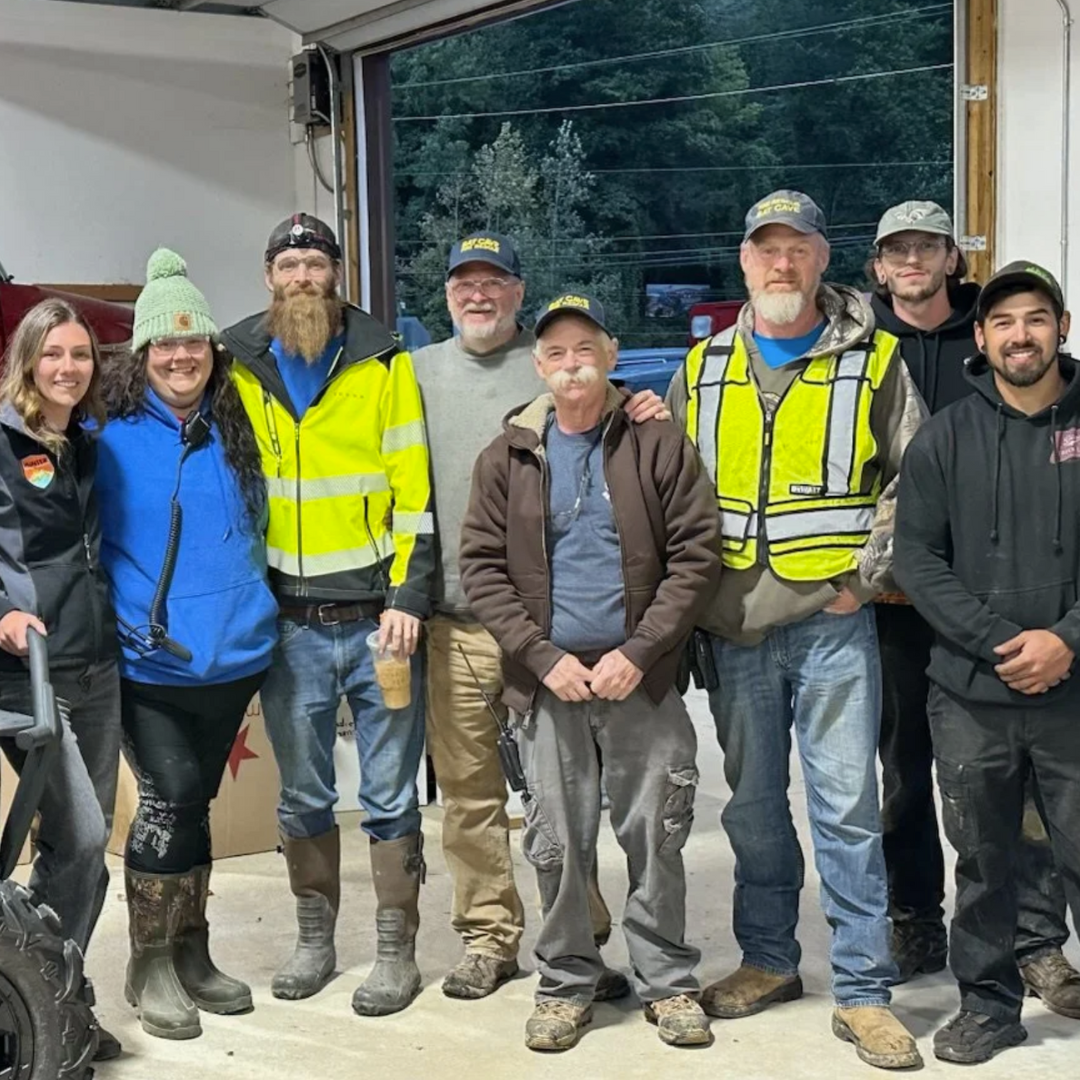

So, rescue efforts temporarily stalled. But only temporarily.
“We made sure everybody was alright,” Freeman said. “Then we came back and started trying to make a plan. And that’s when the helicopters started coming in.”
The helicopters were an answered prayer. But it quickly became evident that there weren’t many safe places to put them on the ground. That was handled first.
“The next day or two, we were taking farm tractors, an old skid steer, just anything we could find to open up the roads enough to get the sick and elderly out down to the landing zones. We ended up with five different landing zones in Bat Cave, the first one being here at the bridge and the firehouse. The second was at the end of Possum Hollow, and we landed the Blackhawks in the riverbed where it had washed out. And then we had one up Hwy. 9 and two on top of the mountain. And I had firemen at each one of those, and we were talking radio to radio.”
Not only were the helicopters saving lives by getting people out, they were serving just as important a purpose by bringing supplies in. Eight people and their pets or a suitcase at a time left on Blackhawks, and four at a time went on smaller helicopters in the gorge and Chinooks up Hwy. 9. At the same time, deliveries of fuel, food, and generators were ferried in as the helicopters returned for more evacuees. All of those were essential to an area that would go without power for 33 days.
After that first week or so, 80 or 85 percent of the people we flew out of here,” Freeman said. “There was nobody left but firemen and their families. And then all the emergency people came in to help us go up and down the river with the cadaver dogs and make sure there were no bodies. The dogs would hit on anything - deer, bears, cattle, anything - and all of that had to be checked and cleared.”
Freeman estimates that around 400 people were evacuated.
How did Freeman and his department coordinate their efforts? Sometimes it was literally one minute at a time.
“There's no book on it,” he said. “We had to do it by the seat of our pants and what God laid on our hearts. I'm not that brave, but when I had that near-death experience, I knew what we had to do, and it's the same deal. Everybody in my department you talked to was going through something similar, but we all knew we had to stick together and make it work, and even the people that weren't in the fire department stuff. all come together, everybody worked together and made that happen. And I think it just relies back on your life experiences and everything to make that work.”
“Everybody just came together”
Soon, help getting folks off the mountains turned to help putting the mountains back together. The list of those who stepped up to help is long, and Freeman doesn’t want to forget anyone. But he said quite a few groups came to help early, and are still there today.
“Right off the bat, Samaritan’s Purse was in here,” he said. “Jon Stone, on their disaster team, was over the helicopters. He’d come in here a couple of weeks after in his Samaritan uniform and asked to see me. And when I met him, he said ‘you know me, but you don’t know me’. I said well, who are you? And he said ‘I’m your helicopter guy’.”
Stone was the voice on the other end of Freeman’s efforts to coordinate helicopter drops and fire personnel staffing in the right places. Samaritan’s Purse was one of many boots-on-the-ground groups. Sheep Dog Impact Assistance, the United Cajun Navy, and the 92nd Airborne Civil Division all responded.
“I know I’ll leave somebody out,” Freeman said. “We had church groups come in here from all over. Everybody worked together. It wasn’t just one group doing one little thing. We had people come in from all over the country, as far away as Pennsylvania and Ohio and everything come here to just run a chainsaw or do whatever we needed.”
Jake Jarvis and Ethan Fowler, both with grading companies, were among the first to make the roads in the Bat Cave area passable for heavy equipment. Spokes of Hope followed, with Shane Zecolle of the Horry County-based group committing to help build back Chimney Rock Village - and beyond.
“They’ve moved up here,” Freeman said. “Spokes of Hope is just right across the street from us right now. And they’ve committed to being here until we get the whole Gorge built back. And not just Bat Cave and Gerton but all the way to Green River, up to Middle Fork, up number 9 into Buncombe County.”
Spokes of Hope worked with Great Needs Ministry in Lancaster County, Pennsylvania. Great Needs is a group of Amish volunteers who travel to help in times of need.
“They brought the Amish in and helped rebuild all of Chimney Rock,” Freeman said. “And then after that, I got to go up there with Shane and show that video, and they’ve committed to a year in a half. So they will be coming down here. They’re just not here the next couple of weeks because they’re getting their crops up in Pennsylvania. Then they’ll be back full force all winter long.”
“It’s just the cards we’re dealt”
The rebuilding process is going to take that long, and longer. Tourism and tourist dollars are a vital part of life in the area, and the rebuild has a lot of those areas open for business as the fall season begins. But day-to-day life won’t be anywhere close to normal for a while.
“It’s dangerous,” Freeman said. “It’s not that we want to keep people out of here. If you just go around and look, we’re still one-lane roads where you’ve got to wait on somebody and alternate. Tourists don’t understand that. We’ve got red lights in here and it’s timed so you can’t be taking pictures when you’re going through down there and all that. It’s mainly a safety issue because there’s steep drop-offs and stuff. And us in the fire department, it’s harder to get people other than to fly them in a helicopter. It’s harder to get them to the hospitals that are 20 miles away, any way you go.”
Freeman said it’s important to remember that just because part of the area is going to be business-as-usual, that’s not an across the board fact.
“Down the road it's a whole different situation than it is here,” he said. “I think it needs to work hand in hand. I don't know if everybody realizes that or not, but the big draw is yes, you've got to have the stores, you've got to have this, and a place for the tourists to go. But they need to realize what’s going on. People are coming to see the beauty of everything here, and now they're coming to see the disaster of everything here. And they just need to be patient and let us get the roads back, because we've still got houses and stuff that needs to be built that we couldn't get concrete trucks and stuff in here. We couldn't haul stuff off. And that's why we're so much behind. And it's nobody's fault. It's just the cards that were dealt. If there's anything I get out of this is I want to let the public know that yes, we'll be open, it's not going to be this year for up here.”
While the timetable isn’t certain, one thing that’s for sure is that Freeman and his department are going to keep working, keep rebuilding, keep helping. He says that’s what he’s got to do.
“Well, when you have that near-death experience… I've been saved for years,” he said. “I was in a win-win situation. If it’d have crushed my head, I would be in heaven. But I knew when He let it back and all that, material stuff means absolutely nothing. I knew we had to go help other people. Because if that happened to me, what's going on with everybody else? And it just changes your whole perspective on it.”
Note: The rebuilding and recover efforts in the Bat Cave area are extensive and ongoing. Samaritan’s Purse and Spokes of Hope are still accepting volunteers, while both of those as well as Great Needs Ministry are accepting donations. Please read more about each organization at the links provided.

